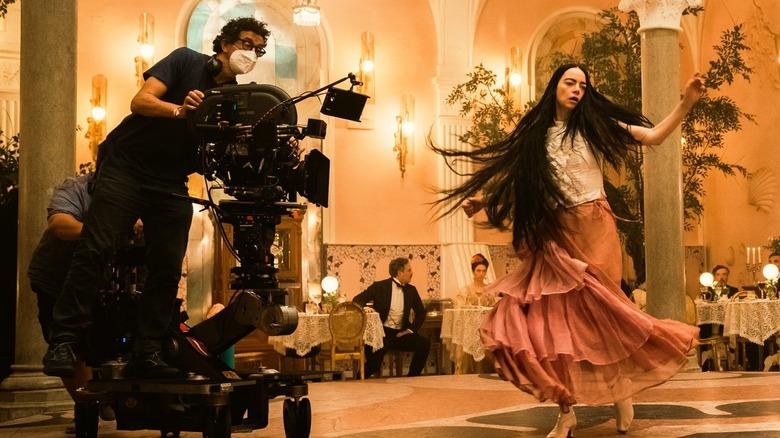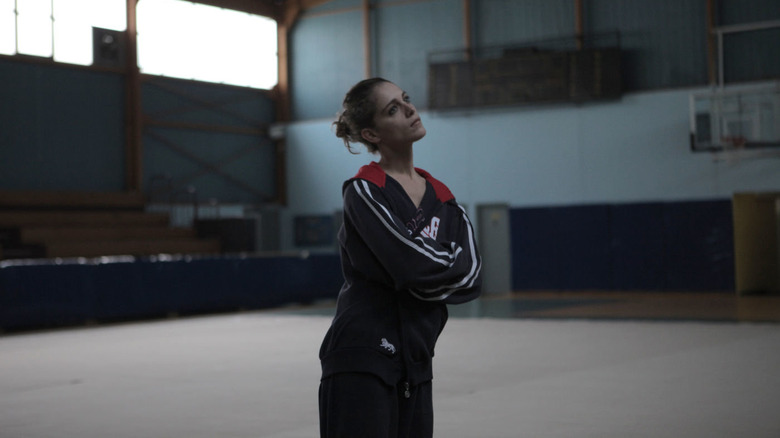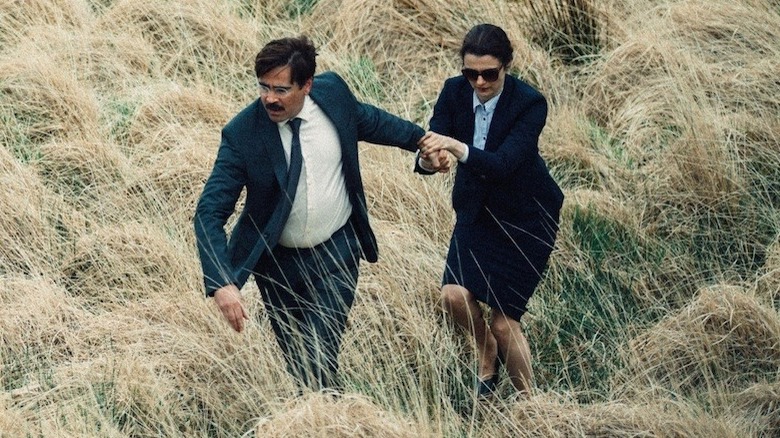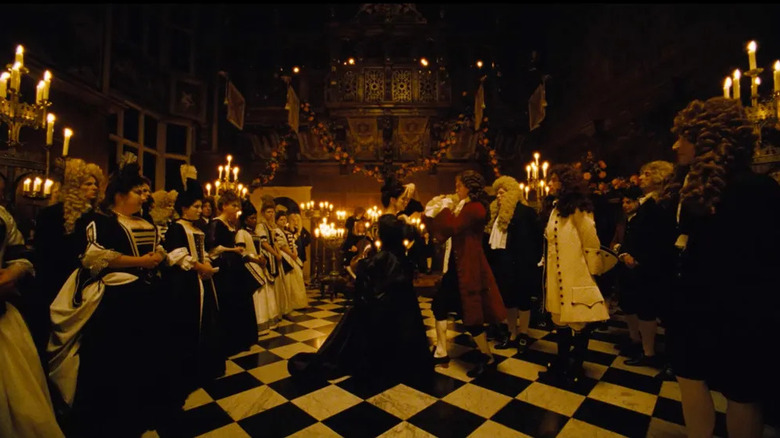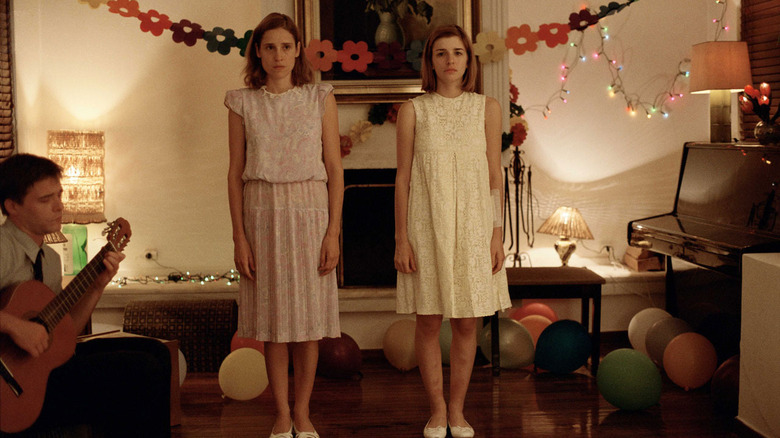Emma Stone's Weird Dance In Poor Things Isn't Even The Most Wild Yorgos Lanthimos Dance
A "bizarre dance sequence" could be a square in a game of Yorgos Lanthimos-themed Bingo. When I watched "Poor Things" (screenplay by Tony McNamara) at the New York Film Festival, the film's contender for Greatest Guffaws occurred when the free-spirited Bella Beatrix (Emma Stone), a Frankensteinesque reanimated woman, bounces onto the ballroom floor with abandon. Her rakish paramour Duncan Wedderburn (a hilarious Mark Ruffalo) joins in and marvels at her untamable spirit, though she would end up burning out his patience later. Living in a steampunk Victorian setting of futurism and antiquity, Bella's dance is her proverbial middle finger to restrictive "polite society."
Weird dancing — or odd choreography — is a vital ingredient to Lanthimos' directorial idiosyncrasies, given that dance is an extension of power, control, or conformity. His early 2005 "Kinetta" engages in a litany of sloppy homicide reenactments, and several of his films followed up with his signature "weird dances." The weirdness isn't the point as much as it is the dancers' expression against their environment.
A ribbon dance
It's tricky to decipher the 2011 "Alps," which follows a group that provides the service of standing in for deceased persons. When expelled from the "Alps" group, the "Nurse" character (Angeliki Papoulia) undergoes a climatic downward spiral and forces herself into a social dance space with an old woman, with the strong implication that she's trying to act as her father. She turns so frantic that the dance transforms into a brawl.
Another character's dance threads together the film's incidents. The movie opens with a young Gymnast (Ariane Labed), an Alps member, rehearsing a ribbon dance to "O Fortuna." When she pleads to her Coach (Johnny Vekris) for pop music, the coach insists she isn't ready for that music and threatens to break her legs. Fortunately for her, the Nurse cuts a deal with the coach to bring her pop music. The bookend dance has the Gymnast joyously showcase her physical capacities to "Popcorn," her desired music. The film's final shot provokes us to wonder about the oblique nature of the Coach-gymnast relationship, possibly implying that they are reenacting other people. Regardless, by ending the film with the Gymnast's happiness, it seems to deliver an emotional release that the Nurse was searching for.
Be couple or die
The dystopic "The Lobster" satires a society where people must couple up or be turned into an animal. Or else, they can be resigned to being a hunted "Loner" in the woods, and single Loners who don't stay single bear the wrath of the Loner Leader. Rival societies conduct their own dispassionate dances. First, within the insularity of the hotel ballroom, singles must court potential matches, with men and women respectively uniformed in identical apparel. On the other end of the spectrum, forest Loners are welcomed to have a silent disco but are outlawed from dance partners, leading to a comical victory dance of humans voguing robotically and averting eye contact with anyone. The Loner's forest dance is eventually counterpointed by a later forbidden romantic slow dance–a "synchronization exercise"–between David (Colin Farrell) and the Short-Sighted Woman (Rachel Weisz). Although shot from the distance, their slow dance adds warmth to the cold woods surrounding them, as if their defiant star-crossed love is forging their own galaxy away from prying eyes.
Breakdancing in 18th century
Sharing the cinematographer Robbie Ryan, the "Poor Things" choreography finds its closest twin in the ballroom of the 18th-century "The Favourite," in which Lady Sarah Churchill (Rachel Weisz) and the ladder-climbing Abigail Hill (Emma Stone) compete for the favoritism of Queen Anne (Olivia Colman).
Just when the ballroom choreography fools you into a period-accurate dance, Sarah and her male partner (Joe Alwyn) break into full-throttle contemporary maneuvers that include voguing and breakdance. The sudden anachronism is absurdly funny thanks to choreographer Constanza Macras, who shared with Vulture that they applied names to the moves, such as "Frog," "off with her head," and "sit, sit, sit." After all, "It's much easier to know the step called 'the exorcist,' and then voguing!'"
But the comedy is underscored by close-ups of the recuperating Queen's despondency as she watches Sarah, her current "favourite," flaunt her physical freedom. Consumed by jealousy, the Queen orders Sarah to wheel her to her chambers. They have a wordless lover's quarrel before they give in to their passions in bed. Sarah's dance helps complete the portrait of the war of control between Queen and Sarah: Anne exercises her Queenly powers to have Sarah at her beck and call, while Sarah utilizes her mobility to provoke the Queen's sights on her. But I argue that "The Favourite" does not illustrate the most viscerally intense dance of Lanthimos' universes.
Winner of weirdness: a chilly flashdance
The 2009 psychodrama "Dogtooth" delivers a gruesome tale of family dysfunction. An overlord father (Christos Stergioglou) and mother (Michelle Valley) keep their two daughters (Angeliki Papoulia and Mary Tsoni) and son (Christos Passalis) confined within a gated compound. The parents groom them to be frightened of the world beyond the walls by fabricating stories and fake facts, such as, a stray cat is a dangerous beast that murdered their (made-up) exiled brother who lived outside the fence. But smuggled VHS tapes led to a domino effect of the elder daughter's rebellion.
At their parent's anniversary party, the two sisters perform a dispassionate dance, shifting in stiff shuffles and head nods for their orderly parents. The younger daughter grows exhausted and sits out, but the elder presses on and takes liberties with her movement. She overexerts herself until her mother orders her to her seat where she chomps away on a cake in adolescent rage. When observing her spastic twirls, sloppy jeté, and rigid upward thrusts, a cinephile can discern the elder sister's attempt to copy the choreography of "Flashdance." In contrast to the original "Flashdance" dance, Lanthimos shoots Papoulia's movement with a clinical eye, deflating any possible euphoria and keeping her glumly defined by her parents' stern environment. But you wouldn't need to know "Flashdance" to decipher the rebellion within her graceless dance, especially in the before and after.
Her dance follows after her father forces her and her brother into incestuous sexual intercourse (i.e. rape by parental coercion). Having no language to protest against the act, she adopts the language of forbidden movies to bend her father's rigid order. At the film's climax, she lifts a dumbbell to her mouth and shatters her tooth — the "dogtooth" that her father claims keeps them inside — to ensure her escape from the compound. Such defiance is her own middle finger to her parents' carefully curated prison. It's just a common practice in a Lanthimos movie that an entrapped character must dance for their lives.
